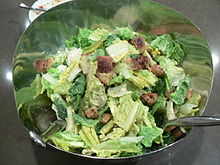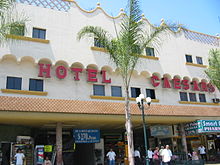This is an old revision of this page, as edited by 68.65.97.143 (talk) at 02:00, 4 May 2015 (The article itself says that anchovies are not used.). The present address (URL) is a permanent link to this revision, which may differ significantly from the current revision.
Revision as of 02:00, 4 May 2015 by 68.65.97.143 (talk) (The article itself says that anchovies are not used.)(diff) ← Previous revision | Latest revision (diff) | Newer revision → (diff) A Caesar salad A Caesar salad | |
| Course | Hors d'œuvre |
|---|---|
| Place of origin | Mexico |
| Region or state | Tijuana |
| Created by | Caesar Cardini |
| Serving temperature | Chilled or room temperature |
| Main ingredients | Romaine lettuce, croutons, Parmesan cheese, lemon juice, olive oil, egg, Worcestershire sauce, black pepper |
| Variations | Multiple |

A Caesar salad is a salad of romaine lettuce and croutons dressed with parmesan cheese, lemon juice, olive oil, egg, Worcestershire sauce, garlic, and black pepper. It is often prepared tableside.
History
The salad's creation is generally attributed to restaurateur Caesar Cardini, an Italian immigrant who operated restaurants in Mexico and the United States. Cardini was living in San Diego but also working in Tijuana where he avoided the restrictions of Prohibition. His daughter Rosa (1928–2003) recounted that her father invented the dish when a Fourth of July 1924 rush depleted the kitchen's supplies. Cardini made do with what he had, adding the dramatic flair of the table-side tossing "by the chef." A number of Cardini's staff have said that they invented the dish.
Julia Child said that she had eaten a Caesar salad at Cardini's restaurant when she was a child in the 1920s. The earliest contemporary documentation of Caesar Salad is from a 1946 Lawry's The Prime Rib (Los Angeles, California) restaurant menu, twenty-two years after the 1924 origin attributed to the Cardinis.

Recipe
The original Caesar salad recipe (unlike his brother Alex's Aviator's salad) did not contain pieces of anchovy; the slight anchovy flavor comes from the Worcestershire sauce. Cardini was opposed to using anchovies in his salad.
In the 1970s, Cardini's daughter said that the original recipe included whole lettuce leaves, which were meant to be lifted by the stem and eaten with the fingers; coddled eggs; and Italian olive oil.
Bottled Caesar dressings are now produced and marketed by many companies.
The trademark brands, "Cardini's", "Caesar Cardini's" and "The Original Caesar Dressing" are all claimed to date to February 1950, though they were only registered decades later, and more than a dozen varieties of bottled Cardini's dressing are available today. Some recipes include mustard, avocado, tomato, bacon bits, garlic cloves or anchovies. Cardini's Brand original Caesar dressing is somewhat different from Rosa's version.
Many variations of the salad exist; for example, by topping a Caesar salad with grilled chicken, steak, or seafood. Certain Mexican restaurants may improvise on items such as substituting tortilla strips for croutons or Cotija cheese for the Parmesan.
Ingredients
Common ingredients in many recipes:
- romaine or cos lettuce
- olive or vegetable oil
- fresh crushed garlic
- salt to taste
- fresh-ground black pepper
- lemon or lime juice - fresh squeezed
- Worcestershire sauce
- raw or coddled egg yolks
- freshly grated Parmesan cheese
- freshly prepared croutons
Variations

There are limitless variations. However, some of the more common are:
- other varieties of lettuce
- grilled poultry (most often chicken), meat, shellfish, or fish
- capers
- Romano cheese
- anchovies
- bacon
Health concerns
There is inherent risk of infection by salmonella bacteria occasionally found in raw egg from cracked or improperly washed eggshells. This is a concern with many similar dressings that are emulsified with eggs, though generally the pH level is thought to be acidic enough to kill those bacteria. Nevertheless, later versions of the recipe call at least for briefly cooked coddled eggs or pasteurized eggs. Recipes may omit the egg and produce a "Caesar vinaigrette". Many variations of this salad exist; yogurt is sometimes substituted for the eggs to maintain a creamy texture and others call for using mayonnaise, oil and vinegar.
See also
References
- David Burke and Judith Choate (2009). David Burke's New American Classics. Knopf Doubleday Publishing Group. p. 67. Retrieved February 11, 2015.
- "Cesar Cardini, Creator of Salad, Dies at 60". Los Angeles Times. November 5, 1956.
Caesar Cardini, 60, credited with the invention of the Caesar salad, died
{{cite news}}:|access-date=requires|url=(help); Cite has empty unknown parameter:|coauthors=(help) - "Rosa Cardini". Telegraph. September 21, 2003. Retrieved 2012-02-10.
Rosa Cardini, who has died in California aged 75, turned the salad dressing created by her father, Caesar, into a staple of modern dining and a million-dollar business. Although the origin of the Caesar Salad is a topic hotly debated by epicures, the generally accepted version is that it was first popularised in the United States in the late 1920s by an Italian immigrant, born Cesare Cardini. He and his brother Alessandro moved to San Diego from Milan after the Great War and then decided to open a restaurant just across the border in Tijuana, Mexico, to attract Americans frustrated by Prohibition.
{{cite news}}: Cite has empty unknown parameter:|coauthors=(help); Italic or bold markup not allowed in:|publisher=(help) - 1987 interview with Rosa Cardini, for Mailpac Magazine, LA.
- ^ In "Hail Caesar", D. Grant quotes Aviator's salad and more (2007)
- 1998 notes on claims:
"Paul Maggiora, a partner of the Cardini's, claimed to have tossed the first Caesar's salad in 1927 for American airmen from San Diego and called it "Aviator's Salad. Caesar's brother Alex had claimed to have developed the salad (he too allegedly called it "aviator's salad"). Livio Santini claimed he made the salad from a recipe of his mother, in the kitchen of Caesar's restaurant when he was 18 years old, in 1925, and that Caesar took the recipe from him. - ^ Julia Child, From Julia Child's Kitchen, 1975.
- "Garden Room at the Town House" restaurant, Los Angeles, menu dated October 8, 1946: "Salads ... Caesar ... 1.50."
- "My father always used Lea and Perrins Worcestershire sauce, and anchovies are one of its ingredients. He meant this to be a subtle salad, and anchovies can be overwhelming." (Above quoted 1987 interview with Rosa Cardini)
- United States Patent and Trademark Office, serial numbers 73426710 "Cardini's", registered 1983 by Caesar Cardini Foods, 73782270 "The Original Caesar Dressing" and "Caesar Cardini's", registered 1989 by Dolefam Corporation, which later merged with T. Marzetti, Search at http://tess2.uspto.gov
- Review on Caesar Salad, by "The Grumpy Gourmet," Doral Chenoweth, quote:
"Today the nearest to Cardini's recipe is a commercial Caesar dressing prepared and marketed by the Marzetti Co." - Marzetti's "Cardini's Original Caesar dressing" is made with soy oil and anchovies, and gluten free, by now— Information on ingredients given by manufacturer
- "Caesar Salad". www.bettycrocker.com. Retrieved 7 November 2014.
- U.S. Department of Agriculture Food Safety and Inspection Service Egg Products and Food Safety
Bibliography
- Child, Julia. From Julia Child's Kitchen, 1975. ISBN 0-517-20712-5
Further reading
- Greenfield, Terry D. In Search of Caesar - The Ultimate Caesar Salad Book, Tjicknor & Fields, 1983.
- Mariani, John F. The Dictionary of American Food & Drink, Ticknor & Fields, 1983.
- Stradley, Linda. What's Cooking America, Chehalem Publishing, 1997.
- Trager, James. The Food Chronology, Henry Holt and Company, 1995.
External links
| Salad dressings | ||
|---|---|---|
| Condiments |  | |
| Types | ||
| Manufacturers | ||